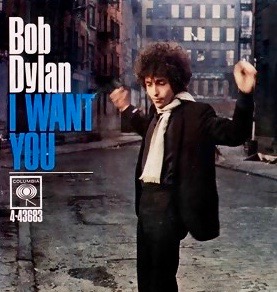A fun pop hit, the chorus of “I Want You” makes clear the singer’s desire while the verses explain all the complications. And that’s what makes this such a great song. If we only had the chorus, it would be a trite love song, but the frenzy of characters and struggles laid out in the verses add the mystery and substance that give the song its lasting appeal.
Dylan told Clinton Heylin, “It’s not just pretty words to a tune or putting tunes to words… [It’s] the words and the music [together]—I can hear the sound of what I want to say.”
The Last Song on Blonde on Blonde
Dylan had abandoned his New York recording studio for Nashville (more on that latter), bringing only Al Kooper and Robbie Roberston with him, otherwise turning to Nashville session guys. “I Want You” has a feel of an impromptu, stream-of-consciousness creation when in fact, Dylan had labored over the lyrics. Al Kooper loved the song and kept pushing Dylan to bring it to the recording sessions. Through much of the recording sessions, Dylan would hole up in his hotel room working on the songs. Kooper would take notes and transcribe the music, then bring it to the studio to prep the rest of the musicians.
Kooper would ask Dylan to bring the song into the studio and Dylan would demur. On the last night, Kooper did it on his own and when Dylan showed up, informed the singer that the band was ready to record it. Between 3 a.m. and 7 a.m. that morning, they cut five tracks, using the fourth take, with some minor overdubs, on the album.
Love Is Simple, Love is Not that Simple
The chorus makes so plain the desire of the singer:
I want you, I want you
I want you so bad
Honey, I want you
Dylan sings this with feeling, even pain. There is no irony.
And yet, the verses make things more complicated. From the very first verse, the song cascades through a cast of wild characters who have their doubts:
The guilty undertaker sighs
The lonesome organ grinder cries
The silver saxophones say I should refuse you
The cracked bells and washed-out horns
Blow into my face with scorn
But it’s not that way
I wasn’t born to lose you
Despite the objections, the singer remains true to the object of his desire. In the next verse, more people get involved – the drunken politician, mothers in the street, even a savior – who all seem to want to come between the singer and his love. And how many of us have not found ourselves in that situation, the friends, parents or siblings who intervene to keep a couple apart.
We then hear a shortened verse with some of Dylan’s best lines:
Now all my fathers, they’ve gone down
True love they’ve been without it
But all their daughters put me down
’Cause I don’t think about it
Others are caught up in obligations, in making appearances acceptable. Others wax about an ideal. But our hero refuses to give in to these traps.
There are other temptations, the Queen of Spades and the chambermaid, other women with their own appeals and offerings. And in the final verse, there is a rival, “your dancing child with his Chinese suit.”
In the end, the singer is still full of passion and longing, still feeling the agony of the love he wants and does not yet have:
I want you, I want you
I want you so bad
Honey, I want you
Sometimes love is that simple.
Recording Blonde on Blonde in Nashville
Context matters. Let’s go back to 1966. Bob Dylan is the ultimate rock star. In those days, the world of rock did not mix with country music. Oh, they may have shared similar roots, but the cultures had become the antithesis of each other. It was shocking for Dylan to go to Nashville to record.
Why do it? The session musicians in Nashville had greater skills and better supported the artist than what Dylan found in New York. Producer Bob Johnston created an environment where the musicians all played together, giving it more a live feeling, which Dylan loved.
This one move changed music forever as it began to bring together county and rock music. Dylan would record two more full albums in Nashville (John Wesley Harding and Nashville Skyline) as well as part of a third (Self Portrait).
Other artists – the Nitty Gritty Dirt Band and Graham Parsons – would build on the country-rock connection, opening a path of likes of the Alman Brothers, the Eagles, Linda Ronstadt and Charlie Daniels (who played on some of those Dylan albums).
Blonde on Blonde Sets New Standards
Blonde on Blonde became the first double record set in the rock world and others, including the Beatles, would follow. It firmly established the album as the main artifact as opposed to the single.
Dylan listed the studio musicians on the album cover, another novel act, which gave them credit and raised their profile. That’s how we learn about Charlie McCoy, Wayne Moss, Joe South and Kenny Buttrey.
#Songoftheday #Spreadinghappiness #Dylan #Nashville #blondeonblonde
YouTube: https://youtu.be/-iIS6ZZ9RVA?si=Tz39aaX7ieVVT-GW
Spotify: https://open.spotify.com/track/7tJQ4Ekp2vN3NlI3vJJW3v?si=33298dca099548a0

